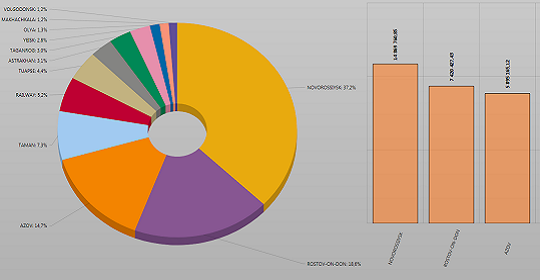Since the beginning of the year, Russian grain exports to China have already exceeded 2 million tons, while there remains room for further growth.
According to experts, Russian grain exports to China have been growing rapidly since 2023.
Rosselkhoznadzor notes that in total in 2023, 5.7 million tons were sent to the Celestial Empire. This is three times higher than in 2022, this value became a new record.
At the same time, it is possible that 2024 will make it possible to break the previously set record, since in the first half of the year 2.2 million tons were already exported to China.
For this reason, it is possible that a significant volume of grain will be shipped before the end of the year, which will make the total value for 12 months even greater than for the previous period.
“The main volumes of export supplies are formed by grain crops, whose share is 40%, which is higher compared to 2023, when their share in exports was 18%.
As of June of this year, the volume of grain crops has more than doubled to 865 thousand tons,” said Ruslan Khasanov, director of the Federal State Budgetary Institution “Center for Grain Quality Assessment”.
At the same time, several crops showed significant growth in supply volumes from Russia to China this year.
For example, barley supplies increased 6 times and reached 377 thousand tons, soybean supplies amounted to 368 thousand tons, which was a decrease of approximately 35%.
At the same time, the supply of peas has increased noticeably: they have doubled and currently amount to 261 thousand tons.
Finally, China is actively purchasing sunflower cake, its supplies have increased 9 times and currently amount to 32 thousand tons.
What are the future prospects for Russian supplies to China?
Analysts believe that supply volumes can also be expected to increase in the future.
The main reason for this is that Russia and China are gradually managing to agree on phytosanitary requirements, compliance with which is necessary for every exporter of agricultural products to China.
At the moment, the requirements for millet have already been agreed upon, which made it possible to supply it to the Celestial Empire in the amount of 12.2 thousand tons. It is noteworthy that a year earlier there were no such supplies, and precisely because of the lack of agreed upon requirements. By the way, last year, supplies of peas to China were agreed upon in a similar manner, which made it possible to begin shipping this type of product there.
Currently, specialists from both sides are also agreeing on requirements for the supply of corn, soybeans, rapeseed, and rice to China.
It is planned that the Chinese side will allow supplies from the territory of the entire Russian Federation, and not just 31 regions, as is currently the case.
In addition, rules are being agreed upon for the supply of winter wheat, barley, semolina, rye flour, soybean meal and several other types of agricultural products.
If the negotiations are successful in all categories, then next year the Russian Federation will be able not only to increase the supply of existing crops, but also to add new supplies to them.

